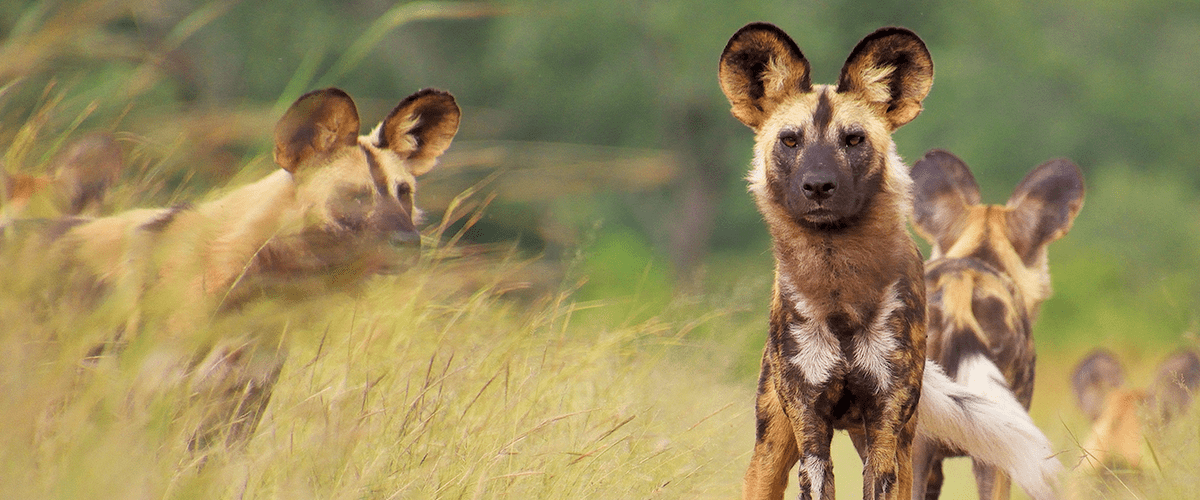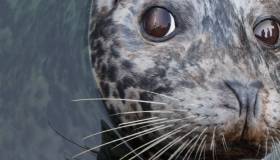
August 25, 2022 – Wild dogs have been around for millions of years, with domesticated breeds emerging around 12,500 to 15,000 years ago. Globally, only about 35 species of wild dog species exist today, divided in broad categories, including foxes, wolves, jackals and other canids. Many are threatened or endangered due to habitat loss, human conflicts and disease.
With the help of generous supporters like you, Morris Animal Foundation has been funding wild dog research for more than 30 years. Our earliest work focused on African wild dogs, when the species was first listed on the endangered species list. Since then, we have helped wild dog species around the world survive and thrive.
Here’s a snapshot of some of our lifesaving wild dog health research.
AFRICAN WILD DOGS
The African wild dog – also called the painted dog because of its multicolored, mottled fur – soon may be listed as critically endangered. Only about 5,000 African wild dogs remain in the wild. Disease and shrinking genetic diversity contribute to their decline, accelerated further by diminished genetic diversity that often makes animals more vulnerable to disease.
To help preserve genetic diversity, Foundation-funded researchers developed a genetic management toolkit including sperm freezing, artificial insemination and behavioral management strategies. Findings helped inform the establishment of a high-quality semen bank that can act as a genetic insurance policy against catastrophic events, such as disease outbreaks and die-offs.
Ongoing research focuses on controlling canine distemper virus (CDV) outbreaks. Our researchers are comparing different vaccination strategies in their study because, as of now, no safe and effective vaccination exists for African wild dogs. Results will help inform vaccination strategies for managing deadly CDV infections in these animals.
MANED WOLF
The maned wolf is the largest wild dog species living in the grasslands and scrub forests of South America. The maned wolf looks like a fox on stilts, but it is neither a wolf nor a fox. Genetically speaking, the maned wolf is a distinct species all by itself in the wild canine world.
Early Foundation-funded studies focused on improving the health and well-being of captive, conservation animals as part of species survival plans. Researchers studied a urinary tract disease that impacted more than half of both captive and wild maned wolves studied, as well as ways to improve reproductive success of maned wolves in captivity for reintroduction.
Later studies focused on maned wolves living in Emas National Park in Brazil, considered one of the strongholds for survival of the species. Researchers developed a number of noninvasive methods, including the use of specially trained scat-detection dogs, to collect maned wolf scat samples. Samples were used to develop and improve laboratory techniques for studying maned wolf health.
The research team was the first to use this field-based survey method outside North America and the first to apply this method for surveying maned wolves. DNA and hormones extracted from samples allowed investigators to assess the population size and the physiological health of the wolves living in and around the park. The results greatly improved our understanding of habitat-use patterns, population trends, stress levels and reproductive conditions that correlate with specific environmental disturbances. Findings were shared with Brazilian and international nongovernmental organizations to improve conservation and management of maned wolves and their habitats.
CHANNEL ISLAND FOXES
The Foundation has long partnered with researchers trying to save foxes living on the Channel Islands off the southern coast of California. These islands are home to many species found nowhere else in the world, including a distinct type of fox species living on six of the eight islands. What makes these fox species so special is each island has a separate and unique subspecies. All subspecies are distantly related to the mainland’s gray fox and genetically separated more than 9,000 years ago.
Early work focused on saving the foxes on Catalina Island, one of the Channel Islands. Ear mite infections associated with cancerous ear tumors was devastating the population. Researchers found that a commercially available drug for ear mites in pets dramatically reduced infection in the majority of monitored Catalina foxes. These findings prompted researchers to initiate ear mite treatment of any foxes handled as part of routine population monitoring. Treatment for ear mites successfully reduced ear mite prevalence and mite burdens in treated foxes and led to a significant decline in the severity of cancer inflammation in Catalina Island foxes.
In another ongoing study, researchers are working with a different subspecies of Channel Island foxes, the San Miguel Island fox. The San Miguel Island fox has declined from a high of 650 adult foxes in 2015 to an estimated 160 adults in 2018. The rapid population decrease coincides with the identification of the acanthocephalan parasite Prosthenorchis sp. in 2012. Before that time, this parasite had not been detected on the California Channel Islands, including San Miguel Island. Researchers are assessing the extent to which Prosthenorchis sp. has caused the fox population to plummet, while determining the best approaches to control the parasite and reduce the likelihood of extinction of the San Miguel Island fox.
HOW YOU CAN HELP
Morris Animal Foundation has supported wild dog health studies since the early 1990s. Other wild dog species we have helped include Arctic fox, gray wolf, red wolf, Ethiopian wolf, Sechuran Fox, San Joaquin kit fox and Darwin’s fox.
You can help protect wild dogs and other species by donating to Morris Animal Foundation. Your gift supports the scientific discovery that advances diagnostics, treatments and cures to improve the health of animals everywhere.




